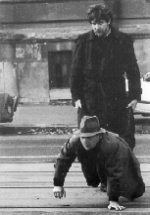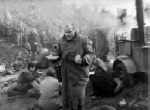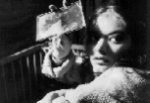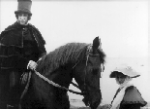
Priváthorvát and Wolframbarát
(149 KByte)
Yet as the years of transition fade into a sobering distance, the hopes cherished about the "new" or "young" Hungarian film vanish into the air. Has anything of importance happened at all to Hungarian film which could be considered related to the changes going on on the social scene? With the disappearance of taboos so often discussed, has there been an end to Hungarian film acting in place of political journalism or its socio-political role? Have the explosive changes in the moving-picture culture, the new movie-going customs, the trend towards a more homogenous taste of the public resulted in strategic changes? Can we observe a change in the attitude of Hungarian film comparable to the restructuring of the economy or the reform of the political institutional system? Can we talk about a new beginning?
I think no, and there is nothing extraordinary to that. To expect redemption where simply new possibilities arise would even be tragic. Yet it is difficult to exploit even these possibilities. No Film Act has been passed until this very day. Legislation is probably blocked by both the old and the new differences of political interest. And there are many who find that the new funding system has not changed anything, - if not for the worse, - and that is an effect true for more than simply the nominal value of grants. Quite clearly, Hungary is not a country where film-making could be exposed to the full impact of the market. Decisive support will have to come from the government. And this is a situation which does not exclude the continued instillation of political expectations, be it subtle or explicit. Therefore, film in our region will continue to be a genre either "oppositional" or "of power", from now on not for political, but for economic reasons. And this is how the greatest obstacle to a change of attitude, the elite-consciousness of our film-makers lingers on and is reproduced. (read the article by András Bálint Kovács in the February issue of Filmvilág). Neither new trends nor the pursuit of a homogeneous style can compensate for the lack of changes in structure and attitude. The belligerent role played by young directors at the 1990 Film Festival has at best been orchestrated by a short -lived and rather defensive interest-group. Nor do we sense change or a new beginning reviewing the most important films of the past decade. What we see is the continuation of traditions.
Twilight, Shadow on the snow, Infanticides, Woyczek are all related in their images and sentiments about life to the 1987 Damnation, and the truly radical change of attitude expressed in these films by the contemplation of philosophical questions and the objective stylisation of the sociological environment is in fact the continuation of the tradition established in 1979 by Andras Jeles's Little Valentino. The idea of putting The Devil's Tango on film preceded Damnation, but producing the film took years. Thus the apocalyptic vision embodied in this grandiose enterprise does not depict the state of life as a result of social changes, but as it was the intention of the creators of the film, a world with which everyday reality has "caught up". We watch this film with the resignation of seeing our own life in that of the dancers, and are not in the least shocked at their negative faith. The audiences is able to receive The Division, Peter Gothar's film pampered for 10 years and now finally completed in a similarly "ripe" state of mind. Think of the effect these films might have had in the years right after Little Valentino. As if the past 5 years had not seen a change of the political system, but a state of affairs after a political system. As if messages put in bottles then would be arriving now to us. It is still easy to remember the "clue" repeated in a perpetuated grammatical-definitional structure in Little Valentino: The orchestra kept playing until the last minute on the sinking Titanic, the Titanic on the sinking orchestra....
The first appearance of the attitude anthologically summarised in Wreckage film is the 1983 Assault and Battery This throws light on the fact that Szomjas had been working with basically the same tools for over a decade. He builds on the mythical genres of film, ( western, crime-stories, ) and on its mythical figures (first of all the vamp), employing a simple dramaturgic pattern, with both verbal and visual humour. At the same time all these story- and myth-elements are placed in a deteriorating Hungarian reality depicted with the accuracy of the sociologist, the stereotype story is put in quotation-marks by a self-reflective narrative, and instead of photographing in a commercially professional way, with great skill and craftsmanship Ferenc Grunwalsky creates a damaged visual world, - as if in a non-professional film. The legitimacy enjoyed until now by the kind of portrayal of the world which is sensitive to the absurdity of common life does not only indicate the effectiveness of the method, but has much to say about the depth of social change in Hungary: looking at it from a " lower photographic perspective" , there is not much happening here, indeed.
Szomjas has openly transplanted the method of non-professional film into his art. This method, however has been incorporated into the film-industry of the era through other original films as well, forming probably the single colourful feature of the 80s and 90s. The disarray and insecurity of the era is well indicated by the fact that there were many a people able to break into the closed fortress of professional film from the outside, without the right degrees, and one of these people, András Szőke, may boast of not only being an accepted member of " professional film", but even its star.
Szőke speaks out in a fresh new voice, quite different from that of film-makers educated at the Academy. He totally disregards all schools and current trends, and does not consider himself a director, but as a dominant personality of a team, carrying the works of art connected to his name on his shoulders both as screen-writer, actor, play-master. His dadaist-surrealist-absurd burlesques have stirred up the dead-water of the academic world of Hungarian film which plays the serious and has a preference for the tragic. That a film-maker may arrive from somewhere else, that the world can be seen from a different angle, and portrayed therefore with different methods, has been vividly proved by the creator of Cotton-Wool Hen and Camping of Europe. The chance to prove this, ( practically the enlargement of super-8 films) however, was the result of the confusion around film-making. Whom the outcome of the disarray will favour remains still to be seen. Szőke's recent films and different artistic expressions evoke doubts about whether in the long run he will be able to be in and out at the same time. Miklós Ács also lost his unique attraction being worn away between "non-professional" and "professional" film. After a momentary lapse of attention, professional community corrects the situation quickly. Once it had to endure "alien elements" intruding its circles, it will do its best to crush them into place as soon as possible.
The films of the past 5 years, strong in their dramatic effect rather than philosophical content, (Stowaways, Meteo, Dizziness, Death-Roads and Angels) added nothing to the new narrative created by Bódy. Experiments continue in the steps of the BBS-tradition, and Uninhabited Man, Life of Marquis de Sade, Paramicha, while not leaving their subculture environment, cannot be related to each other either. Their individual voices are not those of the era, but of their creators.
As regards the films of public interest or the historical unmasking and truth-revealing films, their most striking feature is the complete lack of a change of attitude. We see old patterns filled with new words, resulting in well-known stereotypes. The stories distilled from the daily news of the era of transition could only be told in a legitimate way by a voice firm enough to triumph over day-to- day routine, and to point out man behind commonplaces, and the pattern behind the incidental. Surprisingly enough, it is two of our classical directors who succeeded in giving a valid answer to the new questions of the era. In neither cases is it, however, a change of attitude, but an organic continuation of their world-view and art. Istvan Szabó defends the integrity of the human being carried along by the tides of history in his Sweet Emma, Dear Böbe while Miklós Jancsó's camera portrays the circles of power and manipulation, disintegrating and confused as compared to the 60s, in his Blue Danube Waltz.
It is perhaps the hunger for a real change of attitude which was the motive of the unusually fierce interest preceding the return of András Jeles, having been silent as film-director for a decade. No Man's Land however, turned out to be a surprise, if not a disappointment, for many. The holocaust from a child's angle, told in a rather conventional way, -it was difficult to match this against the image of the director as provocatively original. But leaning closer to the film, we recognise the fine and original solutions typical for his art both in the choice of his theme, the structure of the story and the visual world, yet all this is there in a more silent, refrained manner, due to the missed years, the ripeness of the director's age, but first of all due to the age portrayed. The portrayal of the everyday life of a middle-class Jewish family is not a historical commemoration or a dispensation of justice. The story is rather a warning against the ongoing and continuous devastation in our era, while the expression is an attempt at withdrawing the scope of validity of present-day film. This is the notion which makes this film different from the rest evoking the holocaust. The depiction of the hysteria foreshadowing the horror of devastation, often injected into fallible humour, perplexes the emptying feelings of pity and compassion, and the merging of the adolescent girl's angle with the story of Dickens' David Copperfield puts the position of the narrator into unusual light. The most important ars poetica about the scandal of the century and the new boundaries of expression for film is the last sequence, which, as if going beyond itself, determines the corner-stone of the change of attitude prompted by the change on the Hungarian political scene and the visual change of the world: The story of the feature film entitled No Man's Land has come to an end, thereby ending the possibility of fictional story-telling. The screen shows the transportation of Jews in slowed-down, black-and-white documentary pictures...The (f)actual scandal of the century on non-fictional pictures.
Because the change of the artistic attitude accompanying social change can only be the rethinking of the relationship between fact and fiction. Fiction was rendered by life into a strange situation being so thoroughly soaked in politics, which developed for decades in the region. Its colourful poesy was typically an area where everybody said something else of what he thought. Truth could only be encountered through fiction, whereas today fiction is nourished by fact. And this has a significance beyond the changes of the social system. Its is the result of the media's universal power, going far beyond the borders of our region. Images have encircled us. Before, we would not believe our eyes. Now, we only believe in what we see. If there is anything able to prompt the art of the moving picture to reconsider its role and methods, it will be the realisation that the relationship between fact, image and fiction is in the process of change.
It may seem surprising, yet is not accidental, that this restructuring of reality is more keenly felt by the more realistic documentary than by fiction film. Therefore, in the process of change which Hungarian society and the media undergo it is only the Hungarian documentary's searching for a new identity which gives us a clue about that process. There we are able to pinpoint the old attitude's unavoidable end, and the demand for something new. In the second half of the 80s, documentaries, -through the revealing of the historical semi-past and the unmasking of the political present-, became the consciousness of the nation. Judit Ember's, the Gulyás-brothers', Sándor Sára's and Pál Schiffer's films disclosed, unmasked, preserved, they opened up a way towards the events of the past enwrapped in fear. These people's artistic activities were accompanied by political risk-taking. They often recorded the memory of the living in the last minute. The aesthetic form of visual expression was in these films secured by the credibility of the moving picture. It is not so much due to the method, as to the changes in the external environment, that this kind of portrayal as a genre of art had lost its validity. The role of presenting facts, memories in a credible way has been taken over - as this has become possible- by television and political journalism. Today we expect more of documentaries than mere revealing, unmasking and preserving, or the archiving of truth. What we expect is the creative formation of this revealing, unmasking and preserving. Beyond a confrontation with truth we wish to truly see. We expect to see the truth of archiving. As Miklós Jancsó does that in his Message of stones-series.
Of film artists in the recent years, only Ferenc Grunwalsky was willing to meet the visual challenges of his era. In carefully composed visual wreckage, in rough-and -ready documentarist life-situations, he expresses the drama of man thrust onto the periphery of life, deprived of points of orientation. He emphasises the fate of a sociologically well-definable layer of society as the human being's universal fate. An Entire Day, Little, but very Strong, Goldberg Variations and Utrius, which is different in its story but similar in its philosophical content, are cathartic in more than the depiction of certain qualities of life. The resolute, illusionless heroes in Grunwalsky's films are not satisfied with throwing down sociological or cultural barriers, they pursue the entirety of life - in vain. In order to surpass the sociographical attitude, Grunwalsky developed an autonomous visual world, traditional and up-to date at the same time. His images, -in accordance with his world-view- are disorderly, or to be more accurate, orderless, disregarding academic standards of composition. The pictures "damaged" by video place the close-up declared by Béla Balázs to be the most important means of expression back into its old rights. In our glittering media-galaxy Grunwalsky makes man visible again.
The possibility of a "new beginning" is only evoked by two films. Both break away from the conventional attitude, yet neither is a radical, avant-garde work of art, much rather ostentatiously silent exceptions, sober-minded, solitary contemplation far from the battlefield. And the fact that two radically different world-views and sentiments are intervened in them is not entirely a coincidence. Ildikó Enyedi's My 20th Century claims back, as if in advance, the mystery and rich inscrutability of life, made immortal by the moving picture for over a century by now, from an age called "punitive century" by Jeles. As opposed to that, Peter Reich informs about life deprived of its mysteries, about the zero-point felt within a generation subculture in his I fell for this girl as for no one before. Enyedi throws all kinds of different styles on each other with bewitching effect, alloying film-types, creating sparkling fiction, while Reich, with unparalleled discipline and consistency, not succumbing for a minute to the analysis or pathos almost compulsory in Hungarian film, eradicates of his film ( and here his overseas education might have been of help) all hints of story-telling, thought or emotion, everything which in the traditional sense could stand for something. The former talks about the beginning, the latter about the end - both things that do not exist.

Woyzeck
(49 KByte)

Woyzeck
(44 KByte)

Fog
(38 KByte)

No Man's Land
(28 KByte)

From the West to the East
(64 KByte)

Shadow-Company
(48 KByte)

I Fell for this Girl as for no one before
(44 KByte)

I Fell for this Girl as for no one before
(56 KByte)

